Grasp the nettle
on taking my own medicine
There is a saying in the Taoist Classics: ‘The Sage is sick of being sick of sickness.’
Well, I am no sage, but I have been sick. I am as well, physically, as I have ever been, but I have been experimenting with many aspects of life this year, sometimes mindfully, sometimes by accident, and both ways have taught me, and continue to teach me, a huge amount.
In a living culture, we would have elders to ask about how our discoveries could enrich our community, plus we could ask advice. Instead, I have my gut, good friends, siblings and books. But none of these make up for a lack of real elders, regular community practice, or contemplative time spent alone in nature.
Let me explain. I have gone without formal ‘practice’ for 10 days. No T’ai Chi, no chi kung, no Heart Work, no ‘meditation’, no hand crafts, no reading the Classics, or similar, no hermit time in a hut. In short, 3/4 of the things which keep me sane and well have been absent from my physical and psychic diet since I was last at T’ai Chi class, and more generally, for 3 months. This week I have been surrounded by loving family, eating nutritious food, and walking in beautiful places, such as the Ochil hills in Scotland. So, food, family, stunning landscapes and love are in abundance.
And yet…
It is so long since I have felt the strange, almost teenage ennui that descended this week. I have spoken over the years to other teachers about what happens to us when we do not replenish ourselves and return to our sources.1 Many mentioned a certain regression, stuck-ness, creative block, low mood and inability to concentrate. Until this week, when I finally took my own medicine, that’s where I was abiding. These days, I no longer take it out on other people, but it has been interesting to hear the pathetic (in the true sense) tone of my own ‘self-talk’ over the last week, until at last I grasped the nettle.2
The great weeds
In typical ‘why leave a good thing purely metaphorical, when I could embody it at the cost of only a minor rash?’ fashion, I hauled my sister up the lane to help me gather nettles for some reverse-wrap cordage-making.3 With borrowed sturdy garden gloves and secateurs we walked for ten minutes under the arched canopy of limes, oaks and pines, which earlier that week had held young tawny owls, eager for a snack at dusk. When we got to the corner where there had been a huge 2 metre deep bank of nettles, tall and ready to pick, we found they had been mown to the ground by a machine only half an hour before. Luckily, at the back of every newly cut bank on the driech, drizzly walk home, we found the very tallest and hardiest of nettles which the flail had not reached. As I began to cut the first stems, a woman came out of her house and fixed me with a cool stare from the other side of her garden fence.4 I smiled broadly and shook a sheaf of nettles at her, jovially calling, ‘Nettles, I use them for basketry!’ (not strictly true, but much easier to explain than 2-ply or braided cordage). The woman smiled and said, ‘Take as many as ye like!’ waving magnanimously at the entire roadside, which was, last time I checked, actually under the ownership of Clackmannanshire Council.
These weeds are not loved by all. But to me, as to many herbalists, foragers, bush-crafters and fibre wranglers, nettles are the gift that keeps on giving. In the places where they are native and abundant, such as the UK, it is impossible to use the merest fraction of the crop available from early summer until autumn. Where they are invasive or non-native, they can be picked until they are cleared without any worry about depletion, (which would indeed be a useful side-effect in some cases). I know of dedicated non-native species weaving and basketry projects all across the world, using what is out of place to make what is useful, and to change people’s language around, and relationship to, what is not considered indigenous. Kudzu and English ivy are two good examples of such species in North America.
A sting in the tale
Stinging nettle was the first fibre I ever gathered from ‘the wild’ and made into cordage, in 2009 in Inverness-shire with bushcraft teacher Willow Lohr. Until then, I had made fibres from things I’d found in the house or garden, but I had been more interested in their decorative possibilities, rather than as useful cordage in their own right. The smell of just-peeled nettle, like the cucumber-y scent of stripped willow, (also used for cordage) is never forgotten once experienced. It is somewhere between freshly mown grass, damp earth after rain, and nori seaweed. I love the smell, and immediately feel happier and strangely purposeful as soon as it fills my nostrils. I have always worn gloves to pick nettles despite folk wisdom saying that if you boldly grasp them ‘just right’, they won’t sting. Well, there are ways to pick the flowering tips that won’t sting as much, but seeing as Urtica dioica is utterly covered with tiny stinging hairs, and I am prone to rashes, I have always covered my hands and arms when picking, and have never regretted it. To prepare the stems for use, I pull them through my gloved hands tip to base, then base to tip, after that the stinging hairs are almost all flattened or broken off, and gloves can be abandoned, (if a green under-nail manicure is tolerable). I can remember one of my nephews picking nettles with me on a camping holiday, stoically holding back tears as he got a little stung on his wrists above his gloves while we gathered them. I was intensely proud of him still having a go at it. Nettles are, and should be, a rite of passage for youngsters. As food, medicine, fibre, fodder, fertiliser and tea, they are unrivalled. Once we learn how to approach them, with respect and a little fore-planning, they become allies, even teachers, and we forget we ever saw them as a nuisance or as just weeds.
There is also nothing quite like swishing a sheaf of stripped nettle stems through the air like a birch switch. My sister had a quite the sparkle in her eye as we each walked home with a handful.
Placebo?
In Britain, kids I grew up with were always told to rub our skin with broad-leafed dock leaves (Rumex obtusifolius) if we were stung with stinging nettles, and the two plants often grow handily side by side. In recent years, I read that dock does nothing much for the rash, but the act of rubbing the sore area better is a way for children to feel cared for, or to take care of themselves, thus distracting them from the pain and giving them a sense of agency. The report went on to suggest we should encourage children to use Plantago major or Plantago lanceolata instead, as ribwort or plantain, as they are commonly known, are anti-inflammatory and would actively sooth the rash. I am all for children learning about plants as soon and as much as possible. But as Robert MacFarlane’s The Lost Words showed, children are not being aided by our culture to appreciate nature and natural history, but instead are being made into technological amnesiacs at every opportunity. So for now, as first aid, whether placebo or not: let them rub dock leaves! Only horseradish could be mistaken for it, and the pungent smell of that should be an interesting distraction.5
The bramble door
As I walk along I have always touched plants, picked berries, nibbled rock samphire, sniffed roses, and gathered windfall apples. I am over 50 now and often young parents and their children come and ask me what I am doing in the undergrowth. ‘What is that lady doing, mummy?’ is a common part of my aural landscape, when I am out of doors. It makes me incredibly sad that local adults don’t know the abundance in their own parks, hedgerows and gardens, that they don’t recognise the ABC of super common wild foods where we live: Agaricus campestris - field mushroom, blackberries (Rubus fruticosus) and chestnuts. I saw a child told off for touching a bramble last year, told that ‘it might be poisonous’. Today, as I ate the very first ripe clifftop blackberries I have found this summer, I made a wish that people would recognise these dark beauties and stuff their mouths with them more often.
All through the summers of our childhoods, my brother and I would be sent out with an old ice cream tub to the alley behind the house which backed onto a wooded railway cutting, to gather as many ripe blackberries as we could find, to add to the apple pies or crumbles mum would make. If cars came down the lane, we’d squeeze ourselves against the bushes and hold our bounty safely out of harm’s reach. Cooking apples, margarine, sugar and flour were still pretty cheap in those days and provided our main desserts at the weekend. Bringing home a pound of purple goodness made us feel we were genuinely adding to the family larder, and helping to feed ourselves. If there were too many berries, they were washed and frozen to be used another time. Our hands and mouths were usually purple, too, and our knees were red, either scraped by blackberry thorns or stung by nettles. These were considered trifling inconveniences and were badges of honour gained by reaching just that bit too far over the chain link fence. We weren’t in some rural idyll, it was just a feral edge-lane of a 1970s town, like almost any in England. Our mum was fearful of wild mushrooms and had no knowledge of wild foods beyond blackberries, as far as we knew. But for me the instruction to gather these simplest and most abundant of wild foods was, in retrospect, the door to all my future gatherings. Without her appreciation that our stained hands had contributed to her deliciously oozing, crispy-crusted pies, I could not have finally become someone who uses and teaches natural materials for a living, let alone be able to write a book about foraged art materials.
I often get asked what it was that first set me on a path of embodied arts and embedded-in-nature practice. Somewhere between my first mud pies and garden petal ‘potions’ as a toddler, and blackberry-picking aged five, is a very messy, sticky, answer that is still staining my clothes and leaving dirt under my fingernails, 45 years later.
Reweave mythic time
It’s over ten years now since I first taught someone how to twizzle fibres together to make simple two-ply cordage. I have taught it in the Carpathian mountains of Romania, in the ancient halls of Dartington, and online in a multitude of time-zones at once, across the globe. Most recently, twining a thread was one of the main tasks in my day teaching as part of The Labyrinth and the Dancing Floor. As folk twined bright threads from my old T-shirts, and later made string from nettle, bramble and dandelion6 fibres we had gathered, a deep hush descended on the room. Time for stories to be told, forehead creases to flatten, fingers to do the forgotten work of reweaving mythic time.
When two or more people are gathered together to make a thread, from two or more fibres, perhaps the oldest human story is told again. Not the one with heroes, gods, beasts and villains; but the story underneath that story, the mythic net which holds it all together, gathers the wood for the fire around which all tales are told, mends the pouch in which is kept the shard of flint that lights the tinder of imagination.
In every case, a transformation occurs, especially if someone has struggled to make the thread, has told themself they are just not a practical person, or above this task, or stupid, or not in the mood. At these times it is my job to gently encourage, to demonstrate from a different angle, or find yet another way of explaining the method, until that ineffable moment occurs, and something visibly melts in a person who moments ago was tense with frustration. This is the joy of using the false to cultivate the real. It cannot be faked, it always has to be made fresh, no machine learning can ever approach it.
Myth, like all real things, lives in our bodies, always at our fingertips. Remember, the whole of Song is kept alive in barely two inches of trembling gristle, strung across our living windpipes.
So, this week I spoke with Alys Fowler about the way that twining threads, making cordage and spinning a yarn from what is discarded or considered worthless are all ways towards freedom. The way out of the mirrored labyrinth of the stirring mind is the red thread of connection to nature, our true nature. But this cannot be an empty image, nicely placed on a screen or in a book. We need to forage freedom from the feral edges of the wasteland of the machine. I mean literally; learn how to find food, grow food, make threads, medicine, clothing and shelter, to build community and learn to trust each other, and ourselves, again. While we do and teach these things, we will have time to retell the stories which twist us back into the fibre of reality, that mend the thread that means we can take our place in the cloth of life on Earth, alongside all the other living things.
Last week I was at a loose end. I was frayed. I was unravelling.
(Our language would not be this way if fibre were not so utterly intrinsic to being human.)
But this week I am back in the loop.
What I gathered
Back at my sister’s, in a gap between showers, I sat on the back steps and took a stick and a log from the covered pile in the garden, and while listening to a great podcast featuring
, I gently bashed the nettle stems. Then I dug my fingernails into each stem and opened them up, removing the stiff white inner fibre and putting it into the compost heap. I hung the soft green outer fibres up to dry overnight, so that I could bring them home to use when I teach in the autumn. But I left them at my brother’s place when we got back to London the next day. And so in a minute, when I have set up the microphone to record this essay for you, I will text my brother this koan: ‘Nettle, brackets’. Then he will post them back to me tomorrow and order me brackets for a little writing desk I am making in a hut. And there I will start the next book I have just been asked to write about more wild and ancient art materials, to follow up on the current one.7I now know conclusively that I always need some hand-craft with me, however small. I have known this for a very long time, but I always think, ‘Reading will be enough. Anyway, I’ll be busy with things, and there is so much admin to do on my laptop…’ It has been good to see so very clearly that what I endeavour to teach others is just as true and important for me, and that there is no allure for me in the disembodied life.
The beautiful difficulty of processing nettles is full of haptic richness and provides a broad gateway to what I call land-joy (it needs a better name, but one has not arrived yet…) The fact that perfectly good cordage can be quickly and simply made from the re-dampened nettle8 fibres, or that silky cloth can be crafted by those who would card and spin finer threads from these materials is not the point. When I risk a scratch and a sting for this humblest of strings, I am once again part of the unbroken thread of men and women who have gone into their living surroundings and found their livelihoods, nourishment and home.
To weave ourselves back into mythic life, we only ever needed these things:
1: opposable thumbs, 2: some suitable plant stuff, and 3: time.
The magic is, those first two create the third.
This week’s good things: The Unthanks Sorrows Away. The two songs which always simultaneously lift my spirits and yet make me cry are both by The Unthanks, who I’d not heard of until Paul Kingsnorth told me about the incredible song Mount The Air, years ago. I finally got to see them live in Bath 2022 with my friend Jonny Randall, (who has an great film out now, by the way.) I have put the full-length recorded versions of both these tracks on my ongoing Uncivil Savant playlist for you in Spotify, which is now up to 200 songs. Themes: yearning, connection, uplifting, bittersweet, occasionally earthy. If nettle cordage was a playlist, this would be it. See you next week.
Nb: I do not say ‘recharge our batteries’, as I am not a device. Mental hygiene starts with taking care of the words we use to describe ourselves.
In case you are not aware of the English metaphor, ‘grasp the nettle’ means ‘to tackle a difficulty boldly’.
What most people call string.
A not unusual occurrence for me when foraging.
Horseradish leaf central ribs also give long excellent fibres for cordage which are pale gold and fine like something from Rumplestiltskin or Rapunzel…
My beloved ‘weed’ trinity: nettle, bramble, dandelion. My affinity with and gratitude for these three beings knows no end. The first fertilises everything, the second nurses forests, the third feeds all.
…which comes out this week in USA. Free N American postage and a discount is available if you use the code FOUND23 at checkout, here.
or bramble, or dandelion, or a thousand other wonderful plant fibres.



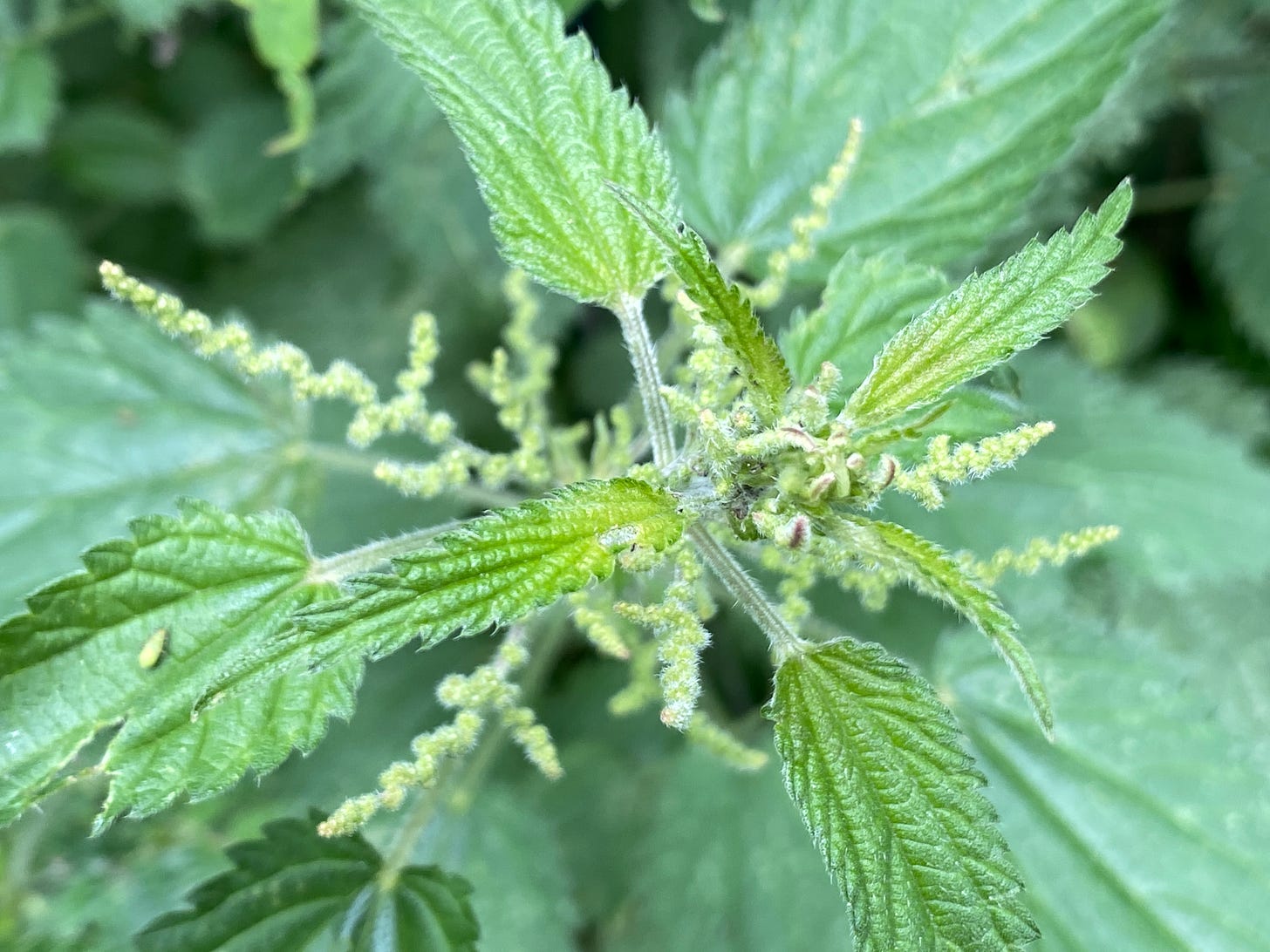
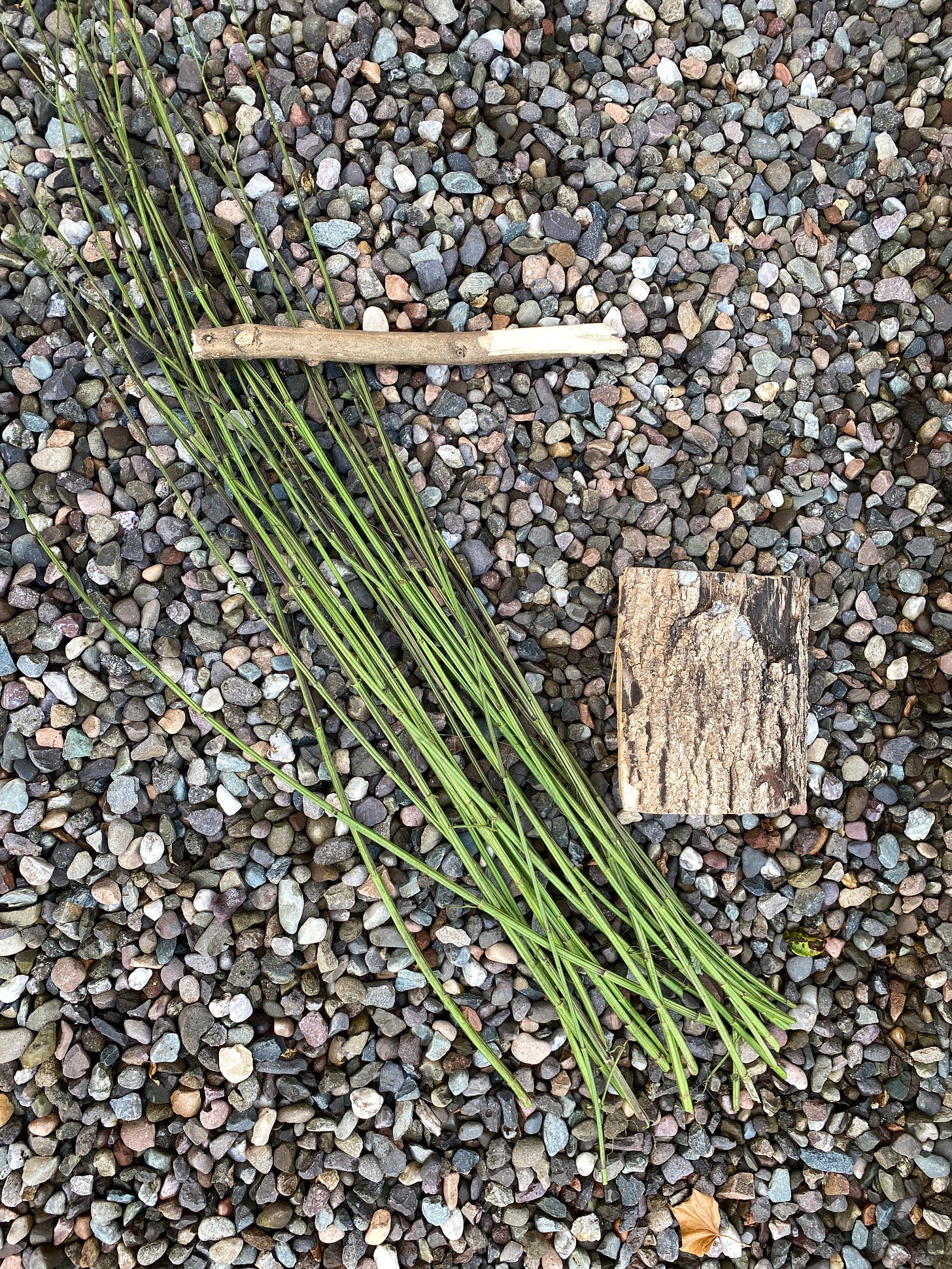
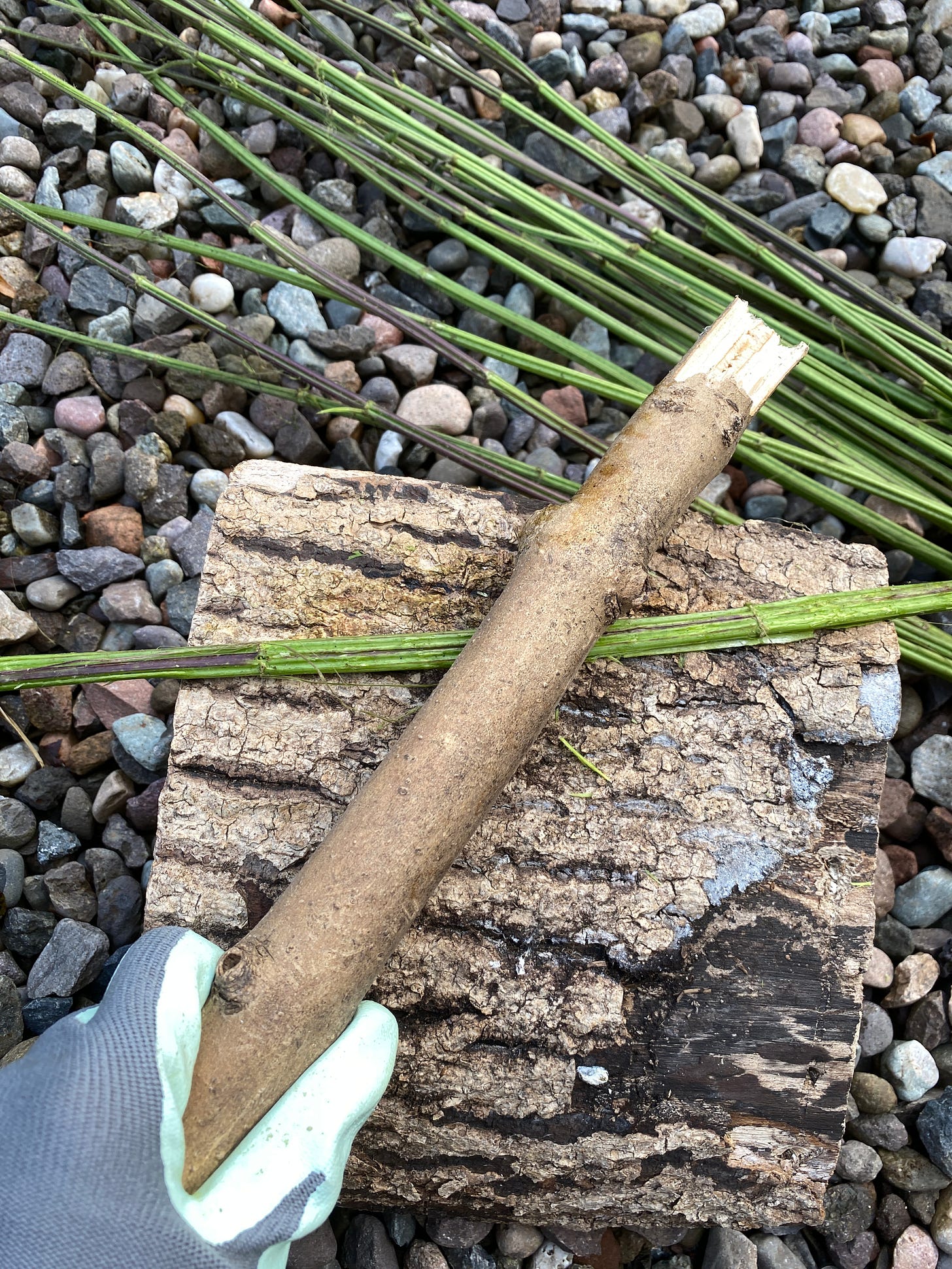
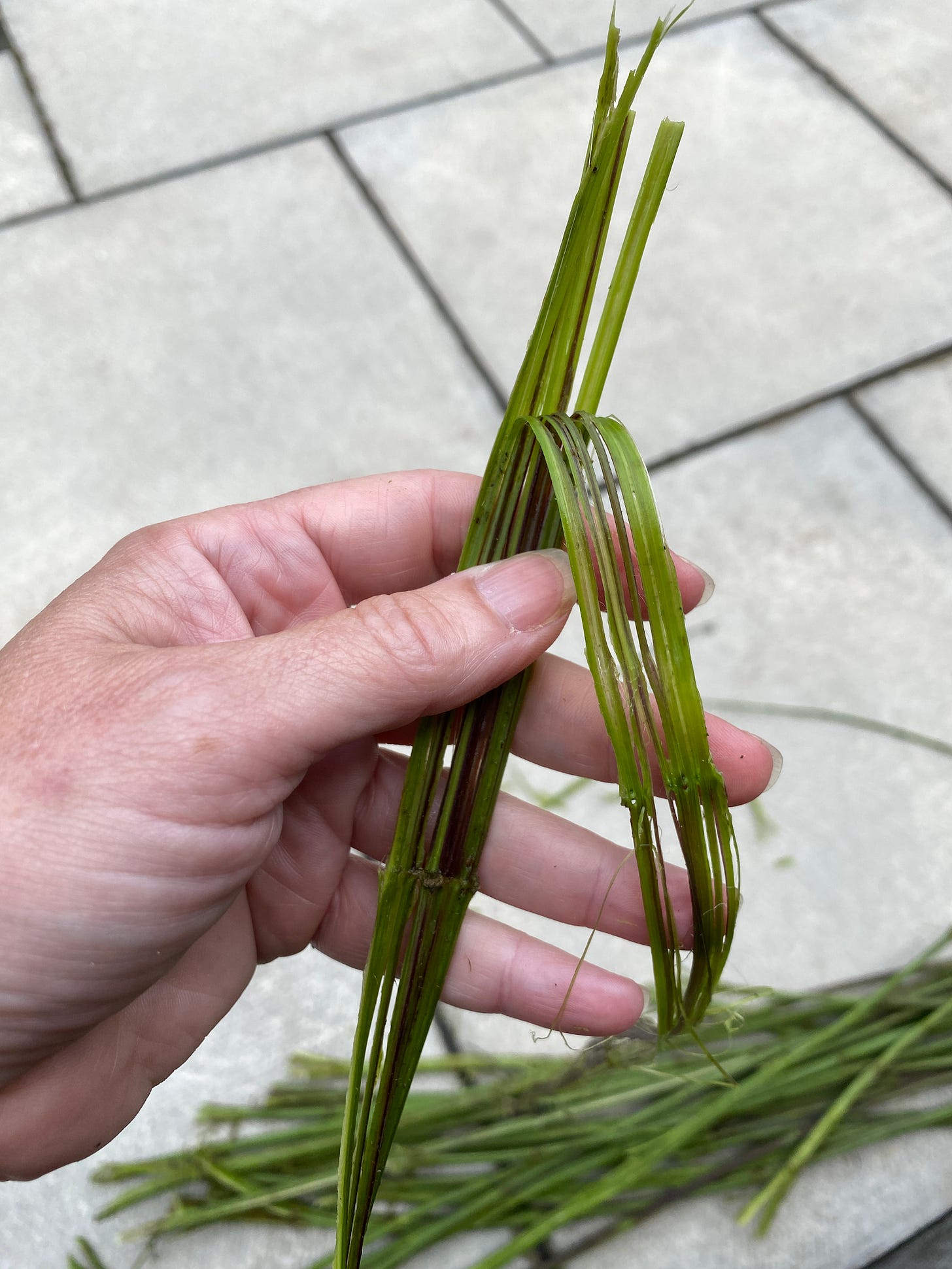
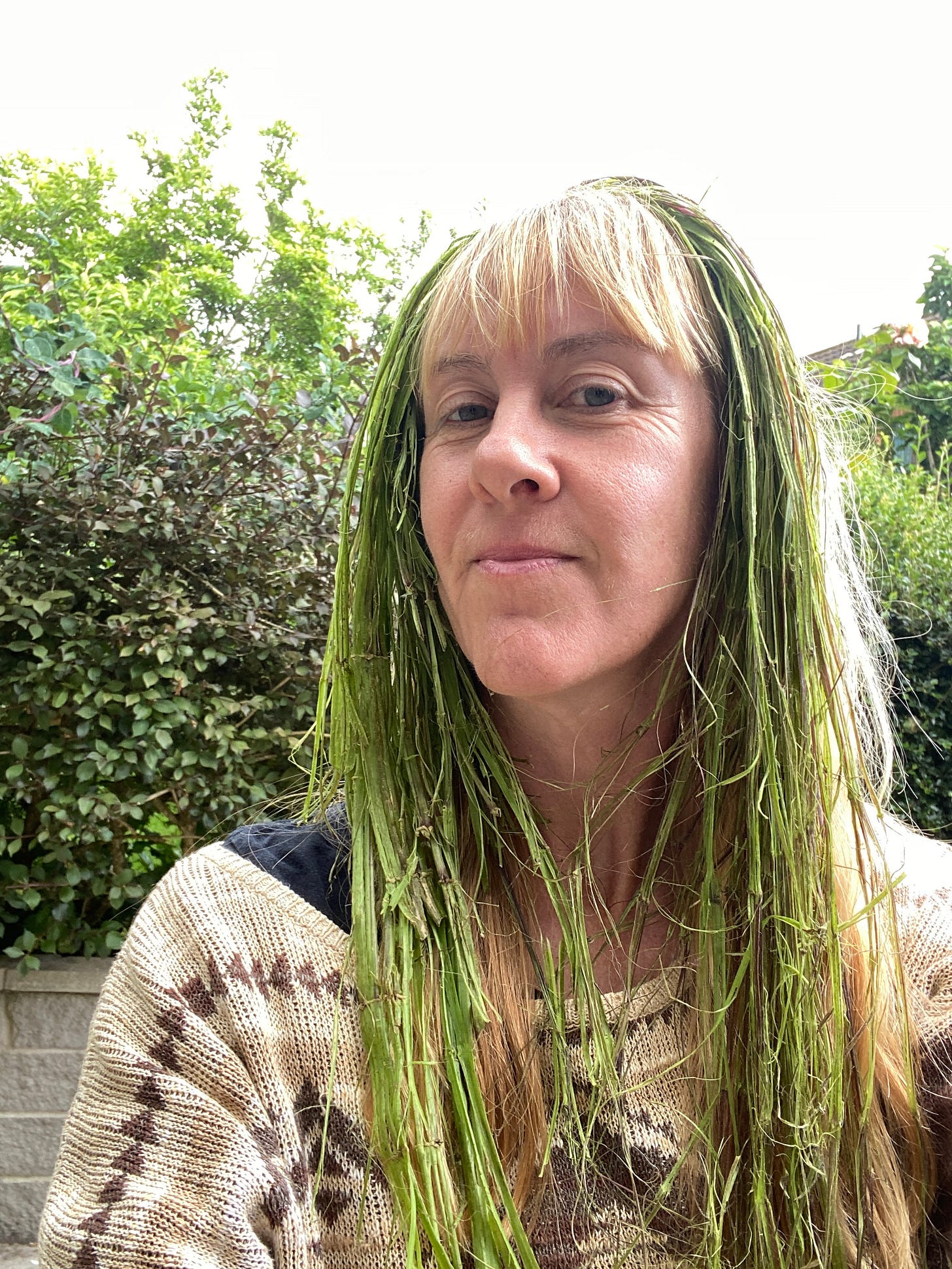

Wonderful!
This made me think of a fortnight ago, teaching a bunch of young kids (strangers... instant friends) that I was playing hide and seek with, to treat nettle stings with nettle juice and how to pick barehanded... before deliberately stinging myself all over my legs to prove that stings could sometimes be reinterpreted as warmth and tingling...
"Can I sting myself...?" immediately asked a wild eyed 5 year old, her voice brilliant with bravery. The nervous, stung and weepy 11 year old grew a little curious and peered on... I delighted in the needling tingle to my legs and the needling injury inflicted upon the machine.
I long to taste those Southern, clifftop brambles again and cook foraged finds with you. Thanks, once again for the perfect start to a week.
Jx
"When two or more people are gathered together to make a thread, from two or more fibres, perhaps the oldest human story is told again. Not the one with heroes, gods, beasts and villains; but the story underneath that story, the mythic net which holds it all together, gathers the wood for the fire around which all tales are told, mends the pouch in which the shard of flint to light the tinder of imagination is kept." Stunning Caroline - you capture what's sensed but been lingering unsaid for me with this passage and the 'mythic net'!!